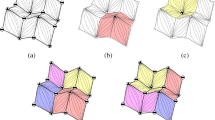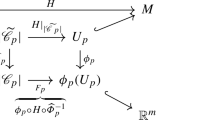Abstract
Digital elevation models can represent many types of geographic data. One of the common digital elevation models is the triangulated irregular network (also called TIN, or polyhedral terrain, or triangulated terrain). We discuss ways to represent a TIN in a data structure, and give some of the basic algorithms that work on TINs. These include retrieving contour lines, computing perspective views, and constructing TINS from other digital elevation data. We also give a recent method to compress and decompress a TIN for storage and transmission purposes.
Research is partially supported by the ESPRIT IV LTR Project No. 21957 (CGAL).
Preview
Unable to display preview. Download preview PDF.
Similar content being viewed by others
References
B.P. Buttenfield and W.A. Mackaness. Visualization. In D.J. Maguire, M.F. Goodchild, and D.W. Rhind, editors, Geographical Information Systems — Principles and Applications, volume 1, pages 427–443. Longman Scientific & Technical, 1991.
CGAL home page. http://www.cs.run. nl/CGAL/.
N. Chiba, T. Nishizeki, and N. Saito. A linear 5-coloring algorithm of planar graphs. J. of Algorithms, 2:317–327, 1981.
K. L. Clarkson and P. W. Shor. Applications of random sampling in computational geometry, II. Discrete Comput. Geom., 4:387–421, 1989.
M. de Berg. Visualization of TINS. In M. van Kreveld, J. Nievergelt, T. Roos, and P. Widmayer, editors, Algorithmic Foundations of GIS, Lecture Notes in Comp. Science. Springer-Verlag, 1997. to appear.
M. de Berg, M. van Kreveld, M. Overmars, and O. Schwarzkopf. Computational Geometry — Algorithms and Applications. Springer-Verlag, Berlin, 1997.
H. Djidjev and A. Lingas. On computing Voronoi diagrams for sorted point sets. Internat. J. Comput. Geom. Appl., 5:327–337, 1995.
D. P. Dobkin. Computational geometry and computer graphics. Proc. IEEE, 80(9):1400–1411, September 1992.
P.-O. Fjällström. Polyhedral approximation of bivariate functions. In Proc. 3rd Canad. Conf. Comput. Geom., pages 187–190, 1991.
L. De Floriani, D. Mirra, and E. Puppo. Extracting contour lines from a hierarchical surface model. In Eurographics'93, volume 12, pages 249–260, 1993.
Wm Randolph Franklin. Compressing elevation data. In Advances in Spatial Databases (SSD'95), number 951 in Lecture Notes in Computer Science, pages 385–404, Berlin, 1995. Springer-Verlag.
Wm Randolph Franklin and A. Said. Lossy compression elevation data. In Proc. 7th Int. Symp. on Spatial Data Handling, pages 8B.29–813.41, 1996.
L. J. Guibas, D. E. Knuth, and M. Sharir. Randomized incremental construction of Delaunay and Voronoi diagrams. Algorithmica, 7:381–413, 1992.
L. J. Guibas and J. Stolfi. Primitives for the manipulation of general subdivisions and the computation of Voronoi diagrams. ACM Trans. Graph., 4:74–123, 1985.
P. S. Heckbert and M. Garland. Fast polygonal approximation of terrains and height fields. Report CMU-CS-95-181, Carnegie Mellon University, 1995.
M. Heller. Triangulation algorithms for adaptive terrain modeling. In Proc. 4th Int. Symp. on Spatial Data Handling, pages 163–174, 1990.
D. G. Kirkpatrick. Optimal search in planar subdivisions. SIAM J. Comput., 12:28–35, 1983.
A.M. MacEachren and D.R.F. Taylor, editors. Visualization in Modern Cartography. Elsevier Science Inc., New York, 1994.
Atsuyuki Okabe, Barry Boots, and Kokichi Sugihara. Spatial Tessellations: Concepts and Applications of Voronoi Diagrams. John Wiley & Sons, Chichester, UK, 1992.
J. O'Rourke. Computational Geometry in C. Cambridge Univ. Press, NY, 1994.
F. P. Preparata and M. I. Shamos. Computational Geometry: An Introduction. Springer-Verlag, New York, NY, 1985.
Relief: depicting a surface on a map. http://acorn.educ.nottingham.ac.uk/ShellCent/maps/relief.html.
N. Robertson, D.P. Sanders, P. Seymour, and R. Thomas. Efficiently four-coloring planar graphs. In Proc. 28th ACM Symp. Theor. Comp., pages 571–575, 1996.
R. Seidel. Backwards analysis of randomized geometric algorithms. In J. Pach, editor, New Trends in Discrete and Computational Geometry, volume 10 of Algorithms and Combinatorics, pages 37–68. Springer-Verlag, 1993.
J. Snoeyink and M. van Kreveld. Good orders for incremental (re) construction. In Proc. 13th ACM Symp. Computational Geometry, pages 400–402, 1997.
J. Snoeyink and M. van Kreveld. Linear time reconstruction of the Delaunay triangulation with applications. In Proc. 7th Europ. Symp. Algorithms, Lecture Notes in Comp. Science. Springer-Verlag, 1997.
S.S. Stevens. On the theory of scales of measurement. Science, 103:677–680, 1946.
M. van Kreveld. Efficient methods for isoline extraction from a TIN. Int. J. of GIS, 10:523–540, 1996.
M. van Kreveld. Digital elevation models and TIN algorithms. In M. van Kreveld, J. Nievergelt, T. Roos, and P. Widmayer, editors, Algorithmic Foundations of GIS, Lecture Notes in Comp. Science. Springer-Verlag, 1997. to appear.
Visualization techniques for landscape evaluation, literature review. http://bamboo.mluri.sari.ac.uk/ jo/litrev/chapters.html.
R. Weibel and M. Heller. Digital terrain modelling. In D. J. Maguire, M. F. Goodchild, and D. W. Rhind, editors, Geographical Information Systems — Principles and Applications, pages 269–297. Longman, London, 1991.
M.F. Worboys. GIS: A Computing Perspective. Taylor & Francis, London, 1995.
Author information
Authors and Affiliations
Editor information
Rights and permissions
Copyright information
© 1997 Springer-Verlag Berlin Heidelberg
About this paper
Cite this paper
van Kreveld, M. (1997). Algorithms for triangulated terrains. In: Plášil, F., Jeffery, K.G. (eds) SOFSEM'97: Theory and Practice of Informatics. SOFSEM 1997. Lecture Notes in Computer Science, vol 1338. Springer, Berlin, Heidelberg. https://doi.org/10.1007/3-540-63774-5_95
Download citation
DOI: https://doi.org/10.1007/3-540-63774-5_95
Published:
Publisher Name: Springer, Berlin, Heidelberg
Print ISBN: 978-3-540-63774-5
Online ISBN: 978-3-540-69645-2
eBook Packages: Springer Book Archive




